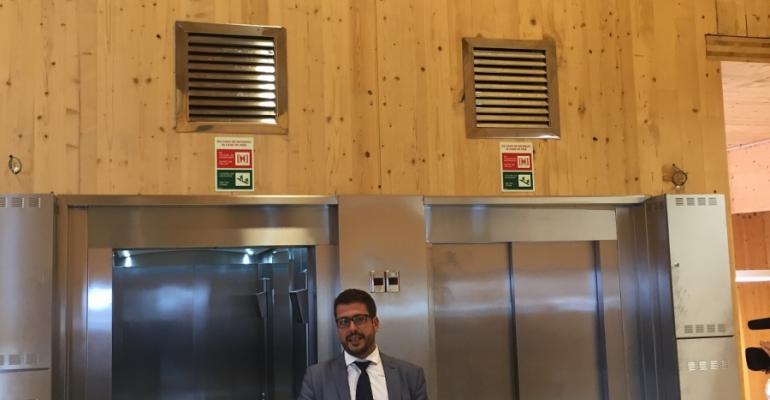The 8,400sq mtr building, connected to an almost 500mtr long quay and capable of handling 5,300 embarking as well as 5,300 disembarking passengers simultaneously, will become operational with the first call expected to take place next week, Ports of Tenerife's commercial director, Airam Díaz Pastor, told media.
On Wednesday the terminal will be presented to the wider cruise industry as the venue of Seatrade Cruise Med's welcome reception and gala dinner.
During the media tour for cruise trade and Canary Islands journalists, Díaz Pastor said Santa Cruz's new terminal represented an investment of more than ten million euros, an amount including two passenger boarding bridges yet to be installed. They are expected to be in place towards the end of the year.
However, the terminal will become fully operational in October after a 14 month building period. The construction contract was awarded in March 2015 to two Spanish ventures, Acciona Infraestructuras S.A. and Constructora de Proyectos y Obra Civil 2012.
The design of Europe's newest terminal was supplied by Miami-based Berenblum Busch Architecture, a firm holding previous cruise terminal references including Royal Carribean's Barcelona terminal as well as the Kai Tak Cruise Terminal in Hong Kong.
Díaz Pastor said the new terminal will be operated and managed by Ports of Tenerife directly – a decision taken not at least in order to retain the direct contact between the port operator and its cruise lines customers, he outlined.
The new cruise terminal is located in the Ribera Dock in an area previously used for fruit export as well as paper import handling. A part of the existing port sheds were preserved and re-used for the cruise terminal, with classic shed structure yet visible inside the luggage hall which comprises the northern section.
Basically, the terminal comprises three parts: The central area operates as the main building, housing the entries/exits lobby, intra-level connections (comprising four escalators, two lifts and two conventional stairways), luggage scanners as well as the dock exit for boarding vessels which do not use boarding bridges.
The terminal's southern end comprises all facilities for embarking guests, including 50 check-in desks, a separated VIP check-in area and room, a 520 seats waiting area as well as a phone and internet area. This part of the terminal also includes offices for security, police, dock personnel etc. Additionally, offices, restrooms and changing rooms are available for incoming operators, cruise line staff, etc. next to the vast check-in area.
The three-storey southern core takes embarking passengers up to a covered walkway which runs all along the quay-facing side of the 200mtr long terminal. Here, the two boarding bridges will be fitted, flexibly connecting the walkway to cruise ships of any size and gangway shell door arrangement. The single-storey luggage reclaim area at the northern end of the terminal boasts vast space for handling and recollection of incoming luggage.
Ten check-in desks at the north-facing side are applied for airline check-in of passengers returning home through one of Tenerife's two airports. Trucks carrying the luggage to the airports can be loaded directly north of the terminal in a restricted area. West of the terminal, a large public parking area accommodates among others 28 shore excursion buses at a time.
Laminated wood has been used throughout the building. Díaz Pastor explained the terminal's decor relate to colours typically found in Santa Cruz as well as in Tenerife's landscape. The red colour used for parts of the terminal's outside structure changes depending on the intensity and position of the sun, giving a varying impression depending on the time of day and year.
The Ports of Tenerife's commercial director stressed cruise lines have been involved with the planning from the first steps. One result of this input is the application of a security scheme differing from most other European terminals: Security inspections of passengers and hand-held luggage take place at the entrance of the building, before passengers approach the check-in desks.
As a result, the majority of the terminal constitutes an ISPS area – contrary to the layout of most other European terminals, which have security controls taking place only after the check-in. 'We asked our cruise line clients for their preference, and they clearly replied they wish the "American Standard" with inspections before the check-in to be implemented,' Díaz Pastor said.
Directly upon entering the terminal through the central area lobby, passengers give up their luggage which is subsequently accessed and processed in an ISPS area inaccessible to passengers.
The terminal has been designed with a focus on energy efficiency, gaining an 'A' class rating as the highest energy rating available for buildings in Europe. CO2 emissions are over 60% lower than in an average type 'D' reference building. Co-funded by the EU – the terminal has been designed with a focus on accessibility. An innovative hearing loop system is installed at all check-in counters for the users of hearing aids. The vast use of escalators – along with lifts – makes the terminal also easily accessible for passengers with reduced mobility.
Copyright © 2024. All rights reserved. Seatrade, a trading name of Informa Markets (UK) Limited. Add Seatrade Cruise News to your Google News feed.


